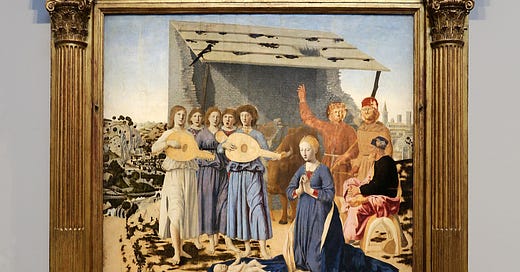Unaware of any historical allegories the most striking aspect of this painting is the blue. Blue which makes us calm and contemplative; the blue of the sky, the mountains, and the town, the stone of which the stable is composed, and the various fabrics. The blue figures seem to be drawn as a whole, and so hover within the frame. The work appears unfinished. Through the donkey we can see the pattern of the wall. Similarly, sword and sleeve are transparent, revealing their backgrounds. Some faces are merely outlines. These faint things are themselves in the background, and our gaze is fixed on the child.
‘And did those feet in ancient time walk upon England's pastures green?'
The words of Blake's JERUSALEM force us to think of England as the Holy Land. In Francesca's painting we see the North of Italy as the setting of the nativity. To the right of the people is the town of Sansepolcro. You should be listening to 15th Century Italian church music. In fact the nativity was probably painted as an altar piece for the cathedral in Sansepolcro. That was at a time when a painting was about the subject, not the mastery of the artist. Piero della Francesca's Nativity is currently in the National Gallery in London; In a new wing designed by Robert Venturi and Denise Scott-Brown. Unfortunately the Sainsbury wing creates a feeling of unease. This painting is wall mounted, off axis, and illuminated by a combination of strongly filtered daylight and yellow spotlights. Perhaps our focus on the figure of the infant Christ is because the painting is placed with the child at eye level. Originally we may have been meant look up to the infant. Not at it. Perhaps we ascribe value to the painting by virtue of where it is and by virtue of its gold frame. Francesca's figures seem able to withstand a displacement of the viewer and thus allow us to relocate the painting. We have already considered the possibility of locating it where it was originally intended. Often, when designing a gallery, which is what I am talking about, that opportunity is not possible. The National Gallery tells us what we think we know. The value of the painting, preserved in perpetuity for our edification and enlightenment. Despite the best attempts of conservers and restorers this painting won't last for ever, and the little text on the wall won't explain everything. Considering alternative locations serves to concentrate on aspects of the work that the gallery resolutely suppresses. Many people visit the paintings each year, they get what they expect. If we were to rehang the nativity at the end of one of the two 'gallery vistas' visitors would comprehend the importance and mastery of the artist. Is the side of a London bus, normally reserved for selling, of any less worth as a site. Without the postmodern fripperies of the National Gallery extension we could perhaps concentrate on the painting. Like the side of the London bus my proposal for this painting is also outside. Seen against the blue of the sky, with the town and the countryside as background the picture stops us and we are suddenly able to concentrate, to feel the calm and the warmth.



